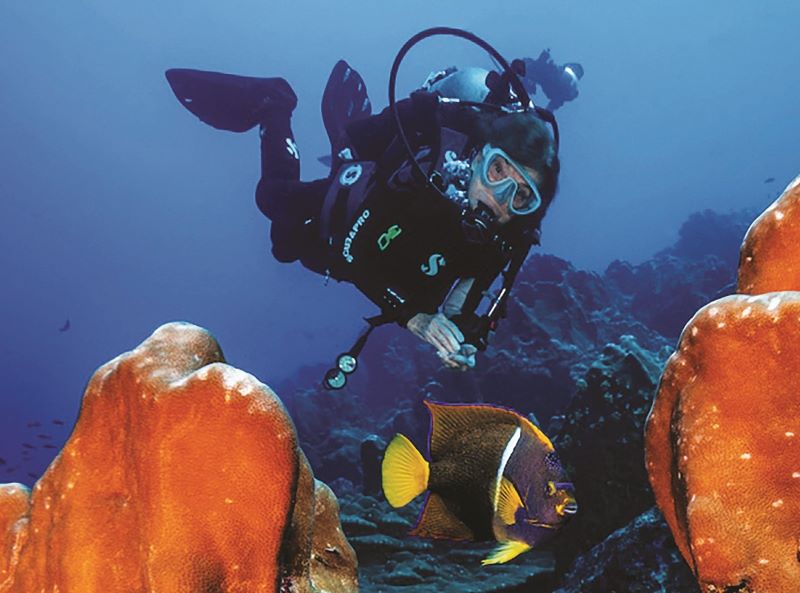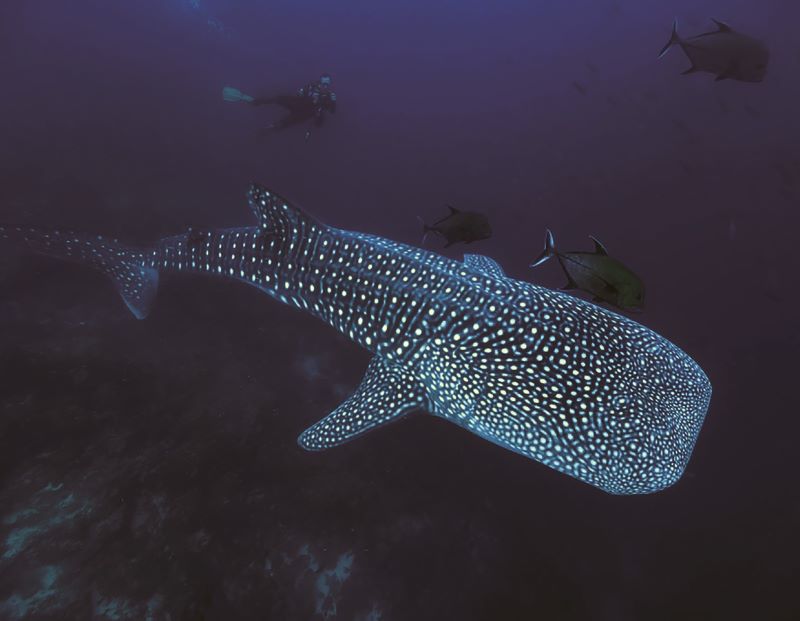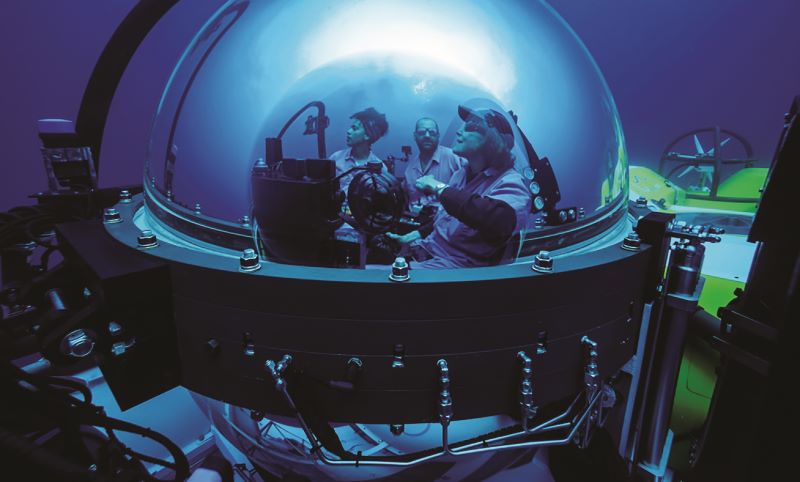
A large male fur seal cruising the waters of the Galápagos Islands’ Hope Spot (All photos: Rolex)
Rolex has supported pioneering explorers pushing back human endeavour’s boundaries for nearly a century. The Swiss watchmaker has moved from championing exploration for discovery to protecting the planet, committing for the long term, to backing individuals and organisations using science to understand and devising solutions to today’s environmental challenges.
This engagement was reinforced with the launch of the Perpetual Planet Initiative in 2019, which initially focused on individuals who contribute to a better world through the Rolex Awards for Enterprise, safeguarding the oceans as part of an established association with Mission Blue, and understanding climate change via its longstanding partnership with the National Geographic Society. Rolex also supports organisations and initiatives fostering the next generations of explorers, scientists and conservationists through scholarships and grants such as Our World-Underwater Scholarship Society and The Rolex Explorers Club Grants.
Mission Blue and Rolex, through its Perpetual Planet initiative, share a commitment to restore and safeguard the world’s oceans by creating a global network of Hope Spots, which are ecologically important areas of the oceans considered vital to the preservation of species or places where communities rely on a healthy marine environment to survive. Since 2014, it has established more than 145 Hope Spots worldwide. Key to the programme is the empowerment of local people to make a change.
Through continued oceanic explorations, Mission Blue has shown how human damage to ocean ecosystems can be reversed. Its groundbreaking expeditions add to growing evidence of the need for increased marine protection. The non-profit conservation organisation was founded in 2009 and is led by legendary oceanographer and marine biologist Sylvia Earle, a Rolex Testimonee since 1982.
A LIVING LABORATORY
04_01.jpg

One of Earle’s first Mission Blue Hope Spots in 2010 was the Galápagos Islands, a geographical gem home to unique species of plants and animals that cannot be found anywhere else on Earth. When she first visited the archipelago in 1966, it was “the sharkiest, fishiest place” she’d ever been. Yet, what makes it unique also makes it vulnerable. As more people discovered the islands, invasive species were introduced, local resources came under increasing pressure, and fishing practices damaged delicate marine ecosystems.
While 97% of the land in the Galápagos was protected, the surrounding ocean did not attract the same attention. With one of the planet’s actual living laboratories at risk, Earle chose the Galápagos Islands as one of her first Mission Blue Hope Spots, somewhere that scientists and local communities would work together to understand and protect the oceans’ health. This gave international visibility to establishing the Galápagos Marine Reserve in 1998, an area covering 133,000 square km (53,282 square miles) of the island’s waters, lagoons and streams. But more work was needed to ensure the Galápagos would be used sustainably for years by residents, tourists and fishermen. “If you can’t protect The Galápagos islands, what part of the planet can you protect?” asks Earle.
DEEP DIVE EXPLORATION
A quarter of a century after the creation of the Galápagos Marine Reserve, the time had come to assess the impacts of these protections, take stock, collect new data, and identify the opportunities and hurdles ahead for the next 25 years. In 2022, Earle and a multi-institutional team of scientists, supported by Rolex’s Perpetual Planet Initiative, embarked on a two-week expedition around the Galápagos to establish a comprehensive and far-reaching overview of the marine ecosystem in the region.
05_05.jpg

Besides monitoring what they could see, the team went on the hunt for “dark diversity” to uncover vital population data for little-studied animals. Diana Pazmiño, a researcher at the Galápagos Science Center at Universidad San Francisco de Quito, used environmental DNA — or eDNA — to capture signals of the rare and enigmatic life around the islands. “It’s based on the fact that all animals are leaving a trace of DNA behind in the environment,” she says.
Pazmiño found that many DNA sequences could not be matched to public databases. She is now creating a library of reference data to help future explorers successfully identify the species they detect. There is also the possibility that some of the DNA she has found belongs to species utterly new to science. “Most of our sequences are not matching any public database, which means that not many things have been sequenced from The Galápagos, or there are things that are new to science that we have not identified yet,” suggests Pazmiño.
It would not be the first discovery for the team. In a previous year, Earle and Salome Buglass of the Charles Darwin Foundation uncovered new kelp species deep under the surface. During the 2022 expedition, the pair boarded the DeepSee submersible to extend their explorations of the depths and surfaced excitedly with footage of lush forests. There are tentative theories that these rich kelp forests play a critical role in supporting the region’s biodiversity. “Kelp forests in other parts of the world have a critical role in supporting biodiversity, and maybe we have found that piece of the puzzle which explains why biodiversity and biomass are so amazingly rich in the Galápagos,” says Buglass.
GETTING IT RIGHT
Manuel Yepez and Alex Hearn are Mission Blue’s Galápagos Islands Hope Spot co-champions, inspirational figures in protecting a vital part of the ocean. Hearn, from the Galápagos Science Center, was the principal investigator on the expedition under Earle’s leadership and convened the international team of scientists who took part. The marine biologist believes that “if we can get it right here [in the Galápagos], that is a blueprint for getting it across the planet”.
05_04.jpg

Fellow research partner Yépez is also instrumental in protecting a vital part of the ocean, Earth’s Blue Heart. A former fisherman, he now logs, samples and distributes information about the diverse marine life he comes across. Together, Yépez and Hearn continue to tag tiger sharks and gather data about a range of shark species, including potential nursery areas.
As lead researcher onboard, Hearn dived and used state-of-the-art underwater video systems to measure populations of many forgotten species, including seahorses and the endemic slipper lobster. This will form a baseline for future surveys, allowing conservationists to check the progress of marine life around the archipelago. Says Hearn: “We need to understand the population trends of some of the key species in our reserve, just to be able to answer the simple question: How is it doing?”
The expedition team continued long-term research into the transoceanic movements of marine animals, capturing location tags recording sharks’ migration from as far away as the Mexican Gulf and coastal Costa Rica. These findings are a potent argument for international cooperation in expanding marine protection.
04_02.jpg

The expedition team also surveyed turtle habitats, mapped the foraging grounds of penguin colonies and measured levels of microplastics. Such a wide range of fieldwork will help conservationists to, as Earle puts it, “think like an ocean”, recognise the connectivity of ecosystems and that, for marine life, there are no boundaries.
In 2021, Ecuador, Panama, Colombia and Costa Rica announced the creation of the Eastern Tropical Pacific Marine Corridor initiative, joining and increasing protected waters to create a fishing-free “swim way” in a critical migratory route for sharks, turtles, rays and whales. While this is an important step forward, Earle and her expedition team’s work shows a need to widen further and increase the number of swim ways.
DEALING WITH TODAY’S ISSUES
Despite the achievements of people like Yépez, Hearn, Buglass and Pazmiño, the Galápagos’ marine ecosystems remain threatened. Since the reserve was established, more residents and tourists have arrived at the islands to enjoy their incredible beauty and diversity. Overfishing has depleted many fish populations, wiping out sea cucumbers almost entirely. Pollution is now a significant issue, and microplastics have been found in some of the reserve’s most remote and pristine locations.
05_08.jpg

The Galápagos are also increasingly feeling the impacts of climate change. Alongside the challenges, researchers have discovered more about the complex migration patterns of the archipelago’s inhabitants, deserving a deeper dive.
The role of connectivity does not end at the water’s edge either. The team has been working with residents and young people to inspire love and appreciation for their homes. “Every time I take a kid snorkelling somewhere in Galápagos, they are amazed by the sharks, turtles and dolphins, and all they want to do is protect them. That gives me so much hope,” says Pazmiño.
Passing on a thriving ecosystem and knowing how to keep it that way is something Yépez wants to be able to do, too, including for the next generations of local fishermen heading out to catch grouper. “The Galápagos is a beautiful habitat for the community and the animals to live together,” he says. “And this is the way."
Jasmine Alimin is an assistant editor at The Edge Singapore.
This article first appeared on Mar 13, 2023 in The Edge Malaysia.


